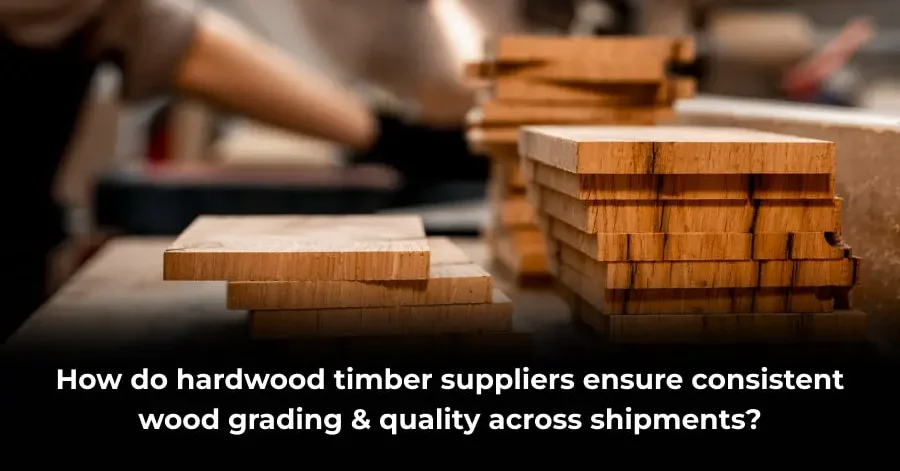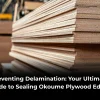For anyone who works with wood—from the hobbyist in their garage to the master craftsman in a professional studio—the relationship with their hardwood timber suppliers is built on a foundation of trust. That trust hinges on one critical question: “Will the next board I order match the last one in quality, character, and performance?”
This consistency isn’t a happy accident; it’s the result of a meticulous, multi-layered process that separates reputable suppliers from the rest. For a discerning woodworking supplies store or an individual artisan, understanding this process is key to selecting the right partner for your materials. Let’s pull back the curtain on how the best in the business ensure that the wood grade you specify is the wood grade you receive, shipment after shipment.
The Foundation: Understanding the Language of Wood Grading
Before a supplier can ensure consistency, they must first speak a common language. This language is defined by wood grading rules. In North America, the most common system for hardwoods is established by the National Hardwood Lumber Association (NHLA). These rules provide an objective, measurable standard for judging the quality of a board based on the size and number of clear, defect-free cuttings that can be obtained from it.
- FAS (First and Second): The highest grade, offering large, wide cuttings ideal for premium furniture and cabinetry.
- Select: Similar to FAS on the best face, but allows for more defects on the reverse side.
- #1 Common: A fantastic choice for many projects, often featuring more character marks like knots and mineral streaks, perfect for flooring and stunning feature panels.
When you browse a supplier’s website or catalog, the wood grade images they provide are not just decoration; they are a crucial educational tool. High-quality, detailed wood grade images help you visualize the minimum and maximum characteristics of each grade, setting accurate expectations before you ever place an order. A supplier invested in consistency will always provide clear wood grade images to eliminate guesswork.
The Human Element: The Skill of the Grader
While the rulebook is essential, the first and most crucial step in ensuring consistency is the trained eye of the lumber grader. These individuals are the gatekeepers of quality. Becoming a certified NHLA grader involves intensive training and a rigorous exam, where they must correctly grade hundreds of boards under a time limit.
This human expertise allows them to interpret the rules in real-world scenarios. They can distinguish between a tight, sound knot that adds character and a loose knot that compromises integrity. They understand how grain pattern, color variation, and natural defects like okoume wood’s occasional silky ray flecks are part of the wood’s charm, not a flaw. This seasoned judgment is irreplaceable, ensuring that each board in a stack labeled “FAS” truly deserves that designation.
The Chain of Custody: From Forest to Forklift
Consistency begins long before the wood reaches the warehouse. Responsible hardwood timber suppliers are deeply involved in the entire chain of custody.
- Sustainable Sourcing: Top-tier suppliers partner with forest managers who practice sustainable harvesting. This not only protects the environment but also ensures a long-term, stable supply of quality species. Knowing the origin of the wood, whether it’s Appalachian Red Oak or responsibly harvested okoume wood from West Africa, is the first step in predicting its quality and behavior.
- Meticulous Milling: How a log is sawn dramatically impacts its stability and yield. Suppliers often work directly with mills they trust, specifying cutting patterns that maximize quality and minimize stress-related defects like warping and checking. For a species like okoume wood, known for its stability and use in marine plywood, precision milling is key to preserving its innate properties.
- The Science of Drying: Kiln & Air Drying Perhaps the most critical phase for consistency is drying. Wood is a hygroscopic material, meaning it absorbs and releases moisture. Improperly dried lumber is a project waiting to fail.
- Air Drying: The process often starts here, where stacks of lumber are stored in open-sided sheds with good airflow, allowing the wood to naturally release a large portion of its moisture.
- Kiln Drying: This is where science takes over. The lumber is placed in a massive, computer-controlled kiln. The supplier carefully monitors temperature, humidity, and airflow according to a species-specific schedule. Okoume wood, for instance, requires a different kiln schedule than dense White Oak. This process stabilizes the wood, kills any insects or fungi, and brings the moisture content down to a precise level, typically 6-8% for interior use. Consistent kiln practices are non-negotiable for consistent shipments.
The Supplier’s In-House Protocol: The Final Check
Once the lumber arrives at the supplier’s facility, their own rigorous protocols take over.
- Re-Grading upon Receipt: Even if lumber comes pre-graded from a mill, reputable hardwood timber suppliers will re-grade it upon arrival. This double-check ensures that transportation hasn’t caused new issues and that the mill’s grading standards align perfectly with their own.
- Organized Storage: A well-organized warehouse is a sign of a professional operation. Lumber is stored by species, grade, and thickness in a climate-controlled environment. This prevents the re-absorption of moisture and makes the picking and fulfillment process accurate. When you order 100 board feet of 4/4 Cherry #1 Common, the warehouse staff can go directly to the correct, stable stack.
- Order Fulfillment with an Expert Eye: The staff pulling your order are an extension of the grading team. They aren’t just grabbing the top boards; they are selecting pieces that match your order’s intent, sometimes even calling a client to ask, “I have a board with a beautiful mineral streak, is that acceptable for your project?” This level of care is what humanizes the transaction and builds lasting relationships with a woodworking supplies store and individual makers.
Case in Point: The Consistency of Okoume Wood
Let’s take a specific example. Okoume wood is a prized African species known for its light weight, stability, and beautiful pinkish-brown hue. It’s a favorite for boat building, veneer, and fine cabinetry. How does a supplier ensure consistency with an imported species like okoume wood?
- Species Verification: They work directly with certified sources in Gabon and Congo to ensure the species is authentic.
- Import Specialization: They understand the intricacies of importing, ensuring the wood is properly packaged and shipped to avoid moisture damage during transit.
- Handling Expertise: They know that okoume wood is relatively soft and require careful handling to avoid dents and bruises in their warehouse.
- Clear Grading Communication: They provide specific wood grade images for their okoume wood inventory, so customers know exactly the character to expect.
This focused approach on a single species demonstrates the depth of knowledge required to be a true specialist, not just a warehouse.
Technology as an Ally: Modern Tools for Ancient Materials
While the human eye is paramount, technology plays a supporting role. Moisture meters are used on every board to verify the kiln-drying was effective. Some suppliers use scanning technology to help with initial sorting. Digital cameras and online platforms allow them to share real-time wood grade images of the actual boards a customer is purchasing, creating ultimate transparency. For a woodworking supplies store ordering large quantities, this virtual “hand-select” capability is invaluable.
AEW Woods: A Standard of Excellence
When discussing hardwood timber suppliers who exemplify these principles, AEW Woods stands out as a benchmark. For decades, AEW Woods has built its reputation not just on an extensive inventory, but on an unwavering commitment to the processes that guarantee quality. They are a prime example of a supplier that understands its role as a partner to the woodworking community.
AEW Woods invests heavily in expert graders, state-of-the-art kiln technology, and climate-controlled storage. They treat every shipment, whether a common domestic species or a rare exotic like okoume wood, with the same level of scrutiny. Their detailed product pages, complete with clear wood grade images and accurate descriptions, make them a trusted source for both a large woodworking supplies store and individual craftspeople. Choosing a supplier like AEW Woods means investing in peace of mind, knowing that your project’s foundation is as solid as the wood itself.
Conclusion
The journey of a hardwood board, from a living tree to a cherished piece of furniture, is a partnership between nature, the supplier, and the craftsperson. Consistent wood grading and quality across shipments is not a mystery but a mastery—a mastery of standardized rules, human expertise, scientific drying, and meticulous handling.
For your next project, whether you’re sourcing for a bustling woodworking supplies store or for your personal bench, choose your hardwood timber suppliers with care. Look for those who educate with clear wood grade images, who specialize in species like okoume wood, and who operate with the transparency and integrity of industry leaders like AEW Woods. In doing so, you ensure that the only variable in your creative process is your own imagination.
Frequently Asked Questions (FAQs)
- Why is there sometimes slight variation in color or grain even within the same wood grade?
Wood is a natural product, not a manufactured material. Grading rules govern the size and number of clear cuttings, not aesthetic elements like color variation or grain pattern. These natural variations are part of wood’s beauty. Reputable suppliers will often group by color if requested. - As a small woodworking supplies store, how can I be sure I’m getting the same quality as a large client?
A professional supplier’s reputation depends on consistent service for all clients. The grading rules are the same whether you order ten boards or a thousand. Look for suppliers who offer transparency, like providing photos of your actual order before shipping. - I’m using okoume wood for a marine project. Does its grade affect its water resistance?
The grade (FAS vs. Common) refers to the appearance and size of clear pieces, not the wood’s innate properties. All okoume wood, regardless of grade, has the same natural resistance to decay. However, a higher grade may be preferable for a hull where a flawless surface is desired. - What is the single most important thing I should look for in a hardwood timber supplier?
Transparency. A supplier that is open about their sourcing, provides clear wood grade images, and is willing to answer your questions in detail is a supplier that is confident in their consistency and quality. - How can I, as the end-user, help maintain the quality of the wood I receive?
Proper acclimation is key. When you receive your shipment, allow the wood to sit in your shop for at least a week, stickered and spaced, to let it adjust to your local humidity. This final step partners with the supplier’s drying process to ensure stability.






